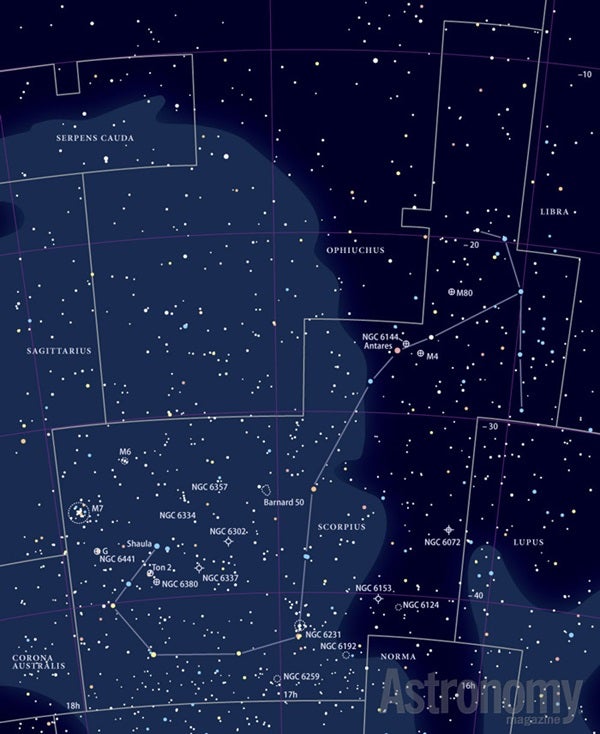Targets for July 23–30, 2015
Small telescope:
Open cluster NGC 6192
Large telescope:
Globular cluster NGC 6235
Large telescope:
Spiral galaxy IC 4633
This week’s small-telescope target is open cluster NGC 6192 in the constellation Scorpius the Scorpion. You’ll find it 2.8° west-southwest of magnitude 3.6 Zeta2 (ζ2) Scorpii. It shines at magnitude 8.5 and measures 7′ across.
Through a 4-inch telescope, you’ll see a dozen stars surrounded by a rich Milky Way field. Despite the background, you’ll identify NGC 6192 easily.
A 10-inch scope reveals 25 stars whose brightness peaks at magnitude 11. Fainter stars sit at the limit of visibility as an unresolved haze surrounding the brighter members. You can observe the cluster through larger scopes, but your star count won’t rise much.
Crank up the power
This week’s first large-scope object is globular cluster NGC 6235 in Ophiuchus the Serpent-bearer. It shines at magnitude 8.9. To locate it, point your scope 5° east of magnitude 4.5 Omega (ω) Ophiuchi.
This small globular (only 5′ across) demands high magnification before it will reveal details, and even then they’re scant. Through a 10-inch telescope at a magnification of 250x, the cluster appears irregular with several moderately dark indentations crossing its border. The most prominent of these triangular depressions lies at the eastern edge. Step up to a 16-inch scope, and you’ll resolve about a dozen faint member stars.
The magnitude 10.8 foreground star GSC 6230:1844 lies 2′ north-northwest of the cluster’s center.
Galactic paradise
This week’s second large-telescope target is spiral galaxy IC 4633 in the far-southern constellation Apus the Bird of Paradise. It glows softly at magnitude 11.8 and measures 4′ by 3′.
This object lies 1.7° east of magnitude 4.2 Beta (β) Apodis at the western extreme of a vast tract of nebulosity. Don’t let all that nearby gas distract you.
Through an 8-inch telescope, you’ll first spot the magnitude 8.9 star GSC 9447:1844, which lies just east of the galaxy’s central region. That area appears as an oval 50 percent longer than it is wide oriented northwest to southeast.
Look just less than 7′ to the east-northeast of IC 4633 for the much fainter galaxy IC 4635. This spiral glows weakly at magnitude 14.0.
Expand your observing at Astronomy.com
StarDome
Check out Astronomy.com’s interactive StarDome to see an accurate map of your sky. This tool will help you locate this week’s targets.
The Sky this Week
Get a daily digest of celestial events coming soon to a sky near you.
Observing Talk
After you listen to the podcast and try to find the objects, be sure to share your observing experience with us by leaving a comment at the blog or in the Reader Forums.











